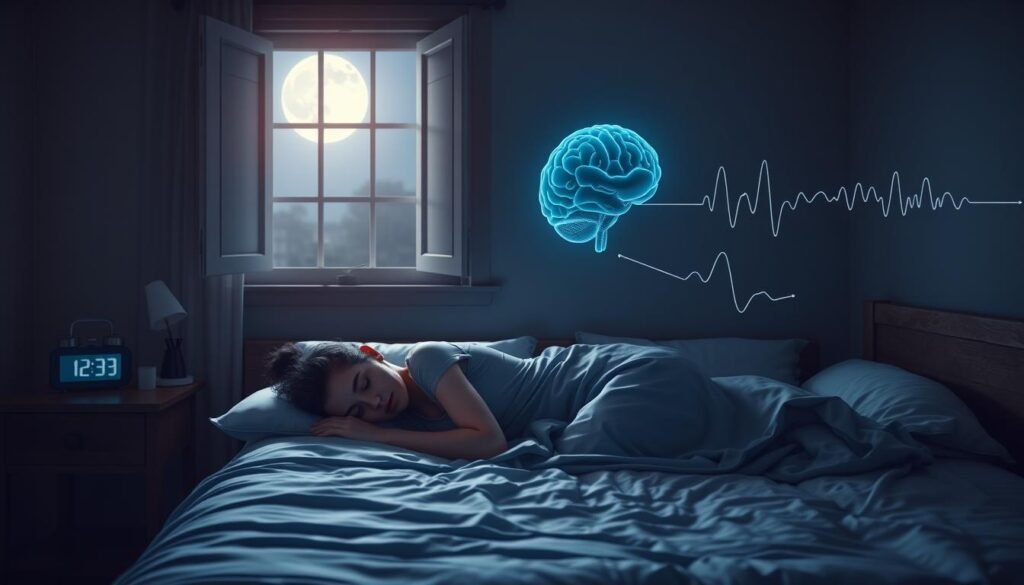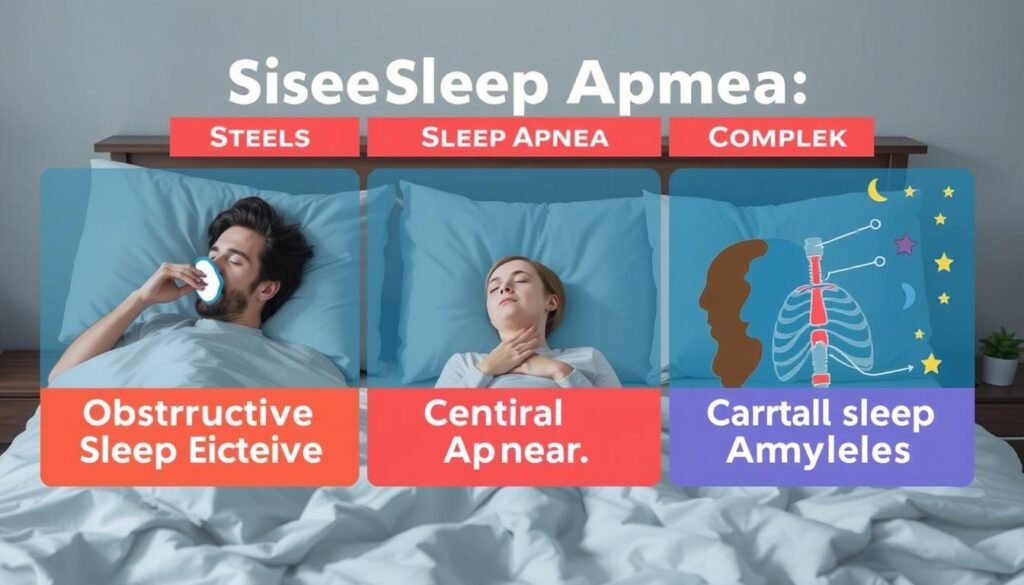Did you know about 22 million Americans have obstructive sleep apnea? This shocking number shows how widespread this condition is. It’s vital to understand its types. Sleep apnea can seriously interrupt breathing while sleeping. Let’s talk about the three main kinds: obstructive sleep apnea (OSA), central sleep apnea (CSA), and complex sleep apnea syndrome.
OSA, the most usual type, happens when airways are physically blocked. CSA is when the brain doesn’t send correct signals to breathe. Complex sleep apnea is a mix of both OSA and CSA. Knowing the differences is key to getting the right help and lowering health risks. For more details on sleep apnea types, visit this resource.
Key Takeaways
- Obstructive sleep apnea affects millions, making understanding its types crucial.
- Men are more likely to experience obstructive sleep apnea than women.
- Central sleep apnea is less common but has significant implications.
- Successful treatment options vary across the different types of sleep apnea.
- Recognizing symptoms can lead to timely diagnosis and intervention.
- Weight management plays a significant role in managing sleep apnea risks.
Understanding Sleep Apnea
Sleep apnea is a sleep disorder with breathing interruptions. These interruptions cause reduced airflow or no breathing, leading to less oxygen. It’s important to know the different types of sleep apnea and how they impact health.
The most common type is obstructive sleep apnea (OSA), which has grown more common. This increase connects to rising obesity. OSA leads to tiredness, fatigue, and mood changes from poor sleep. Not treating it can result in heart issues and metabolic diseases.
Central sleep apnea (CSA) is another form but less usual. It shares symptoms with OSA but has different causes. Complex sleep apnea is both obstructive and central, often found during OSA treatment. Getting the right diagnosis is crucial for the right treatment.
Knowing how sleep apnea affects health is key for getting help early. Diagnosis needs detailed sleep studies. These studies look at brain and heart activity during sleep. This helps find the type of apnea and decide on the best treatment, like CPAP, lifestyle changes, or surgery.
Types of Sleep Apnea (Obstructive, Central, Complex)
It’s key to know the different sleep apnea types for the right treatment. Sleep apnea is split into types like Obstructive Sleep Apnea (OSA), Central Sleep Apnea (CSA), and Complex Sleep Apnea Syndrome. Each type has its own symptoms and ways it’s treated.
Overview of Sleep Apnea Types
Obstructive Sleep Apnea is very common. It affects about 20% of adult men and 10% of postmenopausal women. The main signs are feeling very sleepy during the day, snoring loudly, and gasping for air in your sleep.
Central Sleep Apnea is less common. It happens when you stop breathing for a bit because your body doesn’t try to breathe. Complex Sleep Apnea has signs of both OSA and CSA, making it harder to figure out and treat.
Importance of Sleep Apnea Classification
Understanding the type of sleep apnea someone has is critical for getting them the right help. Knowing if it’s OSA, CSA, or Complex Sleep Apnea means doctors can choose the best treatment. This can really help people feel better.
For instance, CPAP machines are often used for OSA. But people with CSA might need a different kind, like adaptive servo-ventilation. Correctly identifying the type lets healthcare workers give the right care, helping improve patients’ health.
https://www.youtube.com/watch?v=i6lxO6W2-m8
| Sleep Apnea Type | Common Symptoms | Primary Treatment | Prevalence |
|---|---|---|---|
| Obstructive Sleep Apnea (OSA) | Snoring, gasping for breath, tiredness | CPAP, weight management, oral appliances | Affects 20% of adult males |
| Central Sleep Apnea (CSA) | Pauses in breathing, daytime fatigue | Adaptive servo-ventilation, medications | Less common, affects fewer patients |
| Complex Sleep Apnea | Combination of OSA and CSA symptoms | CPAP, adaptive therapies | Varies based on population |
Obstructive Sleep Apnea (OSA)
Obstructive sleep apnea is a sleep disorder where breathing stops and starts during sleep. It’s more common in men and affects different groups of people. It happens when throat muscles relax too much, blocking the airway. This blocks normal breathing at night.
What is OSA?
Obstructive sleep apnea happens with too much throat muscle relaxation during sleep. This blocks your airway. It leads to loud snoring, gasping, and waking up often. This makes it hard to get a good night’s sleep and can cause health problems later.
Symptoms of Obstructive Sleep Apnea
The symptoms of obstructive sleep apnea vary but can greatly affect one’s life. Symptoms include:
- Loud snoring
- Stopping breathing while asleep
- Waking with a dry mouth
- Getting headaches in the morning
- Being very tired during the day
- Having trouble focusing
It’s important to notice these OSA symptoms early to get help.
Risk Factors for OSA
There are several risk factors for OSA. They include:
- Being overweight
- Having a large neck
- Being male
- Getting older
- Having family with sleep apnea
- Smoking and drinking alcohol
- Having a unique throat structure
- Other health conditions
Knowing these factors helps prevent obstructive sleep apnea.
Diagnosis of OSA
To diagnose OSA, you might need a sleep study, or polysomnography. This test, done at a lab or at home, tracks your brain, eye movements, heart rate, and breathing. Getting the right diagnosis is critical to understand how severe the condition is.
Treatment Options for OSA
You can treat OSA with lifestyle changes, CPAP therapy, or oral appliances. CPAP machines keep your airway open by pushing air through. Losing weight and changing how you sleep can also help. Severe cases might need surgery.
| Risk Factors | Details |
|---|---|
| Obesity | High body mass index linked to larger neck circumference. |
| Age | Increased risk as age progresses. |
| Gender | More prevalent in males than females. |
| Family History | Genetic predisposition may play a role. |
| Alcohol Use | Intensifies muscle relaxation leading to airway obstruction. |
Central Sleep Apnea (CSA)
Central sleep apnea (CSA) is not as common as other sleep disorders. It happens when the brain doesn’t send the right signals to breathing muscles. It’s different from obstructive sleep apnea, which is caused by a physical block. Knowing what CSA definition means is key. It helps us tell CSA and obstructive sleep apnea apart.
What is CSA?
Central sleep apnea is when you stop breathing for short times during sleep. This is because the brain doesn’t signal the muscles correctly. There’s no physical blockage in CSA. It’s important to know the causes of CSA, as it can be linked to heart issues or stroke. About 5 to 10% of people with sleep problems have CSA. This is a big number when you compare it to obstructive sleep apnea.
Symptoms of Central Sleep Apnea
The symptoms of central sleep apnea might not always be clear. Common CSA symptoms include:
- Interrupted breathing during sleep
- Waking up feeling short of breath
- Excessive daytime sleepiness
- Insomnia
- Difficulty concentrating
- Mood changes and headaches
In CSA, snoring is usually not a symptom because there’s no airway block.
Causes of CSA
Different things can cause central sleep apnea. Conditions like heart failure or being at high altitudes can lead to CSA. Some medicines, especially opioids, can also cause breathing problems. Sometimes, doctors can’t find a specific reason for CSA, calling it idiopathic central apnea.
Diagnosis of CSA
To diagnose CSA, doctors often use a sleep study. This study checks breathing and oxygen levels while you sleep. During a sleep study for CSA, experts look for when you stop breathing. They also check for any brain conditions that might be causing the problem.
Treatment Options for CSA
Treating CSA usually means dealing with other health issues you might have. Some people might use a CPAP machine to help them breathe while sleeping. Doctors may also suggest other treatments like BiPAP or adaptive servo-ventilation. Treating other conditions you have is key to managing CSA well.

Understanding CSA well can help in finding and managing it. You can learn more here. For more about related conditions, click here.
Complex Sleep Apnea Syndrome
Complex Sleep Apnea Syndrome, also known as ComplexSA, combines features of obstructive and central sleep apnea. Some people with obstructive sleep apnea (OSA) don’t get better with standard treatments like CPAP therapy. It’s crucial to understand ComplexSA’s unique traits for proper treatment.
What is Complex Sleep Apnea?
Complex Sleep Apnea Syndrome is a mix of disorders. It appears in patients who first show obstructive sleep apnea symptoms. Up to 20% of those treated with CPAP for OSA might develop ComplexSA. This condition involves both obstructive and central apnea symptoms.
Symptoms Associated with Complex Sleep Apnea
Symptoms of complex sleep apnea include signs of OSA and CSA. Notable ComplexSA symptoms are:
- Loud snoring
- Pauses in breathing during sleep
- Daytime fatigue
- Shortness of breath upon waking
- Night sweats
These symptoms make diagnosing Complex Sleep Apnea challenging.
Diagnosis and Identification of Complex Sleep Apnea
Diagnosing ComplexSA needs thorough analysis, often through multiple sleep studies. Health experts might recommend a second sleep study 2 or 3 months later. This checks if the condition stays or goes away. Risk factors for ComplexSA include:
- Male sex
- Advanced age
- Opiate usage
- Heart disease
- Severe obstructive sleep apnea
- Higher altitude
- High CPAP or BiPAP settings
Treatment Approaches for Complex Sleep Apnea
Complex sleep apnea treatments target both obstructive and central apneas. Possible strategies for managing ComplexSA are:
- Adaptive servo-ventilation (ASV), great for ongoing complex sleep apnea
- BiPAP therapy, with a backup rate for breathing support
- Lifestyle changes like weight management and sleeping positions
Research shows many cases may improve over time. This means ongoing check-ups and treatment adjustments are vital.
Comparing the Types of Sleep Apnea
Knowing the differences between sleep apnea types is key for the right care. We see that obstructive sleep apnea (OSA) and central sleep apnea (CSA) are different. OSA happens when the airway is blocked physically. This causes breaks in breathing while sleeping. CSA is when the brain does not send signals for regulating breath.
The main differences between OSA and CSA are clear upon closer look. OSA affects around 22 million Americans with most not knowing they have it. It’s often marked by loud snoring and feeling very tired during the day. CSA is less common but causes issues like sleepiness in the day and snoring. People with CSA usually have other health problems that affect breathing.

It’s important to note that Complex Sleep Apnea Syndrome has symptoms of both OSA and CSA. This makes understanding sleep problems complicated. Finding out the exact type of sleep apnea is crucial for the right treatment. This helps doctors take care of patients better by tackling both obstructive and central issues.
| Type of Sleep Apnea | Characteristics | Common Symptoms |
|---|---|---|
| Obstructive Sleep Apnea (OSA) | Caused by airway blockage | Snoring, choking during sleep, daytime fatigue |
| Central Sleep Apnea (CSA) | Caused by the brain’s failure to signal breathing | Daytime sleepiness, loud snoring, morning headaches |
| Complex Sleep Apnea Syndrome | Combination of OSA and CSA | Symptoms from both OSA and CSA |
Understanding the differences between OSA and CSA is vital for the best treatment. Getting the right diagnosis helps in creating treatment plans. This improves life quality for those with sleep apnea.
The Impacts of Sleep Apnea on Health
Sleep apnea influences our health in major ways. It has both short-term and long-term effects. Knowing these impacts helps us understand why treating it on time is crucial.
Short-term Health Effects
Short-term effects include daytime fatigue, trouble thinking, and being easily annoyed. People with sleep apnea often get poor sleep due to breathing pauses. These pauses disrupt sleep, making the next day hard.
Many complain about focus problems and weaker thinking skills. This is common in those with sleep issues.
Long-term Health Consequences
Long-term effects of sleep apnea can be serious. Not treating it links to heart disease, high blood pressure, and diabetes. The risks are higher if you also smoke or are overweight. Effective treatment is key to lowering these risks.
There’s a clear link between weight and sleep apnea. Losing just 10% body weight can greatly reduce sleep interruptions. This shows how important weight management is.
Getting Proper Diagnosis and Treatment
To manage sleep apnea well, you first need a correct diagnosis. Sleep studies, like polysomnography, are key for this. Importance of sleep studies must be emphasized because they track vital signs and breathing while you sleep. This helps doctors decide the right sleep testing for apnea and treatment plan.

Importance of Sleep Studies
Polysomnography helps doctors tell the difference between types of sleep apnea. This includes obstructive, central, and complex forms. Knowing this is crucial for the right treatment. An early diagnosis prevents long-lasting health issues. It also leads to a better life for anyone affected.
Working with Healthcare Providers
Teaming up with doctors is vital when dealing with sleep apnea. Being open about your symptoms and past health helps a lot. Sleep apnea treatment could mean lifestyle changes or using special devices. Doctors work to find the best solution for each person.
This teamwork helps patients understand their sleep apnea better. It also leads to the best health results.
Lifestyle Changes for Managing Sleep Apnea
Managing sleep apnea can be done with lifestyle changes. These changes don’t just control symptoms. They also boost health and happiness.
Weight Management Impact
Weight is linked to sleep apnea. Excess weight, especially around the neck, can block airways. This makes conditions like obesity and OSA worse. Losing weight can make symptoms better and improve sleep. Lifestyle modifications like exercise and healthy eating are key. For some, losing weight ends their OSA symptoms, showing how important a healthy lifestyle is.
Sleep Position Modifications
Changing how you sleep can help with apnea. Sleeping on the back can block airways more. Sleeping on the side allows for easier breathing. Using special pillows or devices can keep you in a good position all night. These changes can make sleep better for OSA patients, helping manage the condition.
Reducing Other Risk Factors
To lower sleep apnea risks, make more changes. Stop smoking, drink less alcohol, and manage allergies. These steps improve sleep and overall health. For guidance on OSA and lifestyle adjustments, check out this helpful guide.
Awareness and Advocacy for Sleep Apnea
It’s important to increase awareness about sleep apnea for early diagnosis and treatment. Public campaigns aim to educate people on sleep apnea’s signs and symptoms. They motivate individuals to get medical help, reduce stigma, and encourage health protection.
Public Awareness Campaigns
There’s growing effort to inform the public about sleep apnea. These initiatives highlight the importance of recognizing symptoms like extreme tiredness during the day and loud snoring. Brochures, educational sessions, and online materials are key in spreading knowledge. They often work with healthcare providers to reach more people, helping them understand and seek help.
Support Groups and Resources
For those with sleep apnea, connecting offers much-needed support. Support groups allow people to share their experiences and learn from others. These groups provide emotional backing and tips for managing sleep apnea. Websites and local workshops also play a big role in educating and improving management techniques for affected individuals.
Conclusion
Knowing about different types of sleep apnea is key to handling it well. Nearly 1 in every 15 Americans is affected. Recognizing symptoms like loud snoring and feeling very tired during the day helps diagnose it early.
Although Obstructive Sleep Apnea is most common, Central and Complex Sleep Apnea are also risky if not treated.
Diagnosis can be hard, as many don’t know they have it for years. This shows why knowing about it is so important. Treatments range from CPAP machines to changing your lifestyle. It’s crucial to find what works best for you.
Effective management improves your life quality and lowers risks from untreated apnea.
Programs that raise awareness are very important. They help people understand and get the help they need for a healthier life. By focusing on education and action, we can make a big difference in fighting sleep apnea.